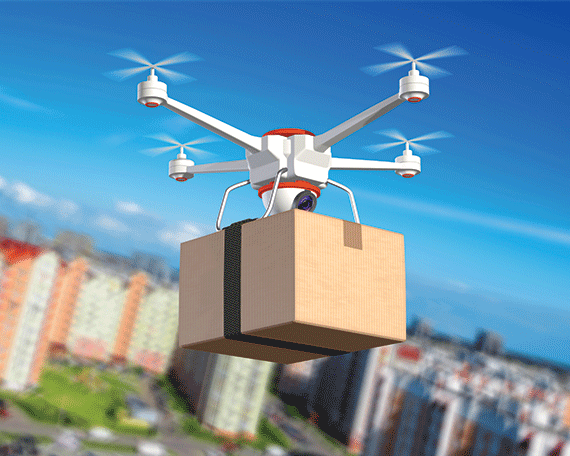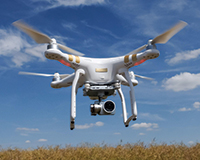 Emma Humphreys and Raza Anjum offer an update on airborne technology’s impact on property
Emma Humphreys and Raza Anjum offer an update on airborne technology’s impact on property
Following the recent announcement that the e-commerce giant Amazon and the British government have commenced a partnership to develop aerial drone technologies, it seems inevitable that these machines are set to play an increasing role in our lives.
Amazon’s aim is to create an airborne delivery system that can get parcels to customers in just 30 minutes and it is surely only a matter of time before commercial drone flights become commonplace. But what of drone use in the property industry? Is there a useful role for drone surveillance and what are the risks involved?
Drones on the rise in property
Recent research carried out by YouGov for a report prepared by Charles Russell Speechlys showed that, compared with other sectors, the property industry is an early adopter of drones. This is particularly true in construction, where 16% of businesses confirmed that they already use drones and 54% said that they plan to use them in the future. Drones are particularly useful to construction companies for surveying sites before and during the construction phase, including to ensure that they comply with health and safety policies.
In real estate, the research showed that 9% of businesses currently use drones and 57% plan to do so. This expected increase is perhaps unsurprising given that drones can survey large and/or hard to reach areas of land quickly and easily. Drone technology clearly offers the chance for innovative and cost-efficient practices for the management of property.
By way of example, Walsall Housing Group became one of the first housing associations in the country to be granted permission by the Civil Aviation Authority (CAA) to fly drones over its housing stock to inspect roofs without the need for scaffolding. The group estimates that the reduction in its estate management costs is likely to be in the region of £20,000 per year.
Drones have also been used in connection with planning applications, in particular to monitor compliance with planning permissions. For example, it was reported that residents in Cambridge used a drone to collect evidence to scrutinise a developer’s compliance with planning conditions in connection with a large-scale residential luxury development. Indeed, Freedom of Information surveys demonstrate that various local authorities across the country are using drones to examine planning applications, review the state of council-owned properties and survey hazardous structures.
The rules and risks
So, will the expected significant increase in the use of drone technology cause any potential legal issues? Half of the real estate businesses surveyed for our firm’s report felt they lacked knowledge about the current rules governing drone use.
However, this probably partly reflects the lack of regulation: the 569-page Air Navigation Order 2009 (as amended in 2015) issued by the CAA contains just three articles relevant to the flying of drones (defined as “small unmanned aircraft” by the CAA). Legal action may be taken by the CAA if the owner of a drone breaks its rules but few individuals have been prosecuted.
Quite separately from the CAA rules, it is possible for unlawful invasion by a flying object to be a trespass where the intrusion is low enough to interfere with the ordinary use and enjoyment of the land and/or buildings beneath. The lack of any physical contact with those land or buildings is irrelevant.
While it used to be thought that property owners enjoyed rights above their land “up to heaven”, it has been recognised by the courts for some time that this would create absurdity and that there is a balance to be achieved between the rights of property owners to enjoy their land against the right of the general public to take advantage of airspace.
Bernstein of Leigh v Skyviews & General Ltd [1977] 2 All ER 902 established that the rights of property owners in relation to airspace are restricted to a height necessary for the ordinary use and enjoyment of the relevant land. Drone users will inevitably argue that flying safely over another person’s property is not a trespass where the flying height does not interfere with the ordinary use of that property.
However, the court in Bernstein warned that a person being subjected to the harassment of constant surveillance from the air, accompanied by the photographing of every activity, would amount to a “monstrous invasion of privacy” and an actionable nuisance for which relief would be given.
Of course, the difficulty with any trespass or nuisance claim – or indeed a claim for any damage caused if a drone crashes into property – will be identifying the person controlling the drone. At present, CAA guidance requires that person to maintain visual contact with the drone but this is one of the requirements which has been relaxed for the Amazon tests.
The CAA’s guidelines are a helpful starting point towards setting standards for the use of drones. However, the European Landowners Organisation is among those who have expressed concerns that drones “present a significant risk to privacy” and that increased regulation is required.
In the meantime, those in the real estate and construction sectors looking to use drones as part of their businesses need to consider their obligations under current data protection and human rights laws, as well as potential privacy and copyright issues.
These types of issues are covered in our report, which can be found at: www.charlesrussellspeechlys.com/insights/latest-insights/tmt-new/ready-for-take-off-navigating-the-legal-framework-around-drones-for-business
Emma Humphreys is a partner and Raza Anjum is an associate at Charles Russell Speechlys








